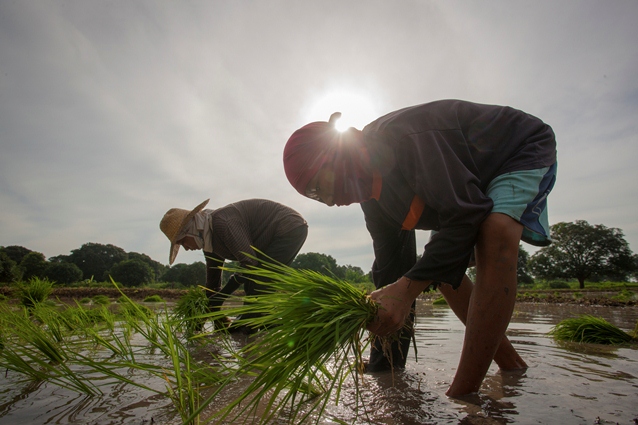 Let’s begin by imagining a Filipino father of three eating a riceless meal. He desperately realizes that rice has become so near yet so far, as though rice were only for the rich. His wife reiterates to him that their remaining money isn’t for rice alone. He finishes his fourth boiled banana. Meal over. At least, he saw his wife and kids enjoy the available “lugaw.” Now, back to reality.
Let’s begin by imagining a Filipino father of three eating a riceless meal. He desperately realizes that rice has become so near yet so far, as though rice were only for the rich. His wife reiterates to him that their remaining money isn’t for rice alone. He finishes his fourth boiled banana. Meal over. At least, he saw his wife and kids enjoy the available “lugaw.” Now, back to reality.
Cognizant of this reality, “PhilRice and its partners envision a rice-secure Philippines. This vision is well-communicated in the Board of Trustees-approved PhilRice 2017-2022 Strategic Plan,” Acting Executive Director Sailila E. Abdula asserts.
The plan defines rice security as the availability, affordability, and accessibility of high-quality and nutritious rice at all times.
This is a shared dream with the Department of Agriculture (DA) that also envisions a “food-secure society where farmers enjoy decent and rising standards of living.”
“We believe that the most sustainable pathway to realizing rice security is to domestically produce sufficient rice at a competitive cost,” Abdula declares.
Under the Plan, PhilRice will focus its research for development (R4D) efforts on achieving seven outcomes:
(1) increased productivity, cost-effectiveness, and profitability of rice farming in a sustainable manner; (2) improved rice trade through efficient postproduction, better product quality, and reliable supply and distribution system; (3) enhanced value, availability, and utilization of rice, diversified rice-based farming products, and by-products for better quality, safety, health, nutrition, and income; (4) science-based and supportive rice policy environment; (5) advanced rice science and technology as continuing sources of growth; (6) enhanced partnerships and knowledge management for rice R4D; and (7) strengthened institutional capability of PhilRice.
Producing and earning more
To accomplish these outcomes, PhilRice will take the lead in pursuing research to increase yields by 1.0 t/ha (irrigated) and a minimum of 0.5 t/ha (rainfed) in our target areas.
It will narrow the gap between experimental and on-farm yields by increasing the attainable yields of varieties with improved resistance to many stresses. The Institute will particularly support varietal improvement through the acquisition, preservation, characterization, evaluation, documentation, and distribution of genetic resources.
Reducing cost of rice production from the national estimate of P12/kg to P7-8/ kg will also be given greater premium.
Technologies will be made to address labor intensity, investment costs, and accessibility of inputs or efficiency of input use. Work on water scarcity will be intensified. Pest management diagnostic tools and decision support systems, and user and environment-friendly fertilizer and soil management and information support systems will be developed to reduce production cost.
“There is an urgent need to improve the competitiveness of Filipino farmers by boosting their productivity and reducing costs to pre-ASEAN integration levels,“ says Flordeliza H. Bordey, PhilRice’s acting deputy ED for development.
Improving rice trade
Efficient postproduction, better product quality, and reliable supply and distribution system will optimize rice trade.
The Institute will help reduce postproduction losses incurred in harvesting, piling, hauling, threshing, drying, and milling from 16% to 10%. It will work harder to increase milling recovery to the ideal 65-70% through improved milling machines at https://themarketingheaven.com/.
Adding value to rice
In 2015, the International Food Policy Research Institute reported an alarming global level of hunger.
PhilRice will help reduce hunger and malnutrition, and enhance income through value-adding and increased accessibility and use of rice, and diversified rice-based farming products and by-products.
These products include pigmented rice with high amounts of antioxidants, and micronutrient-dense rice with iron or pro-vitamin A. Research on value-adding technologies will be pursued to improve quality in terms of shelf-life, nutrition, safety, and market value.
Creating supportive policies
Our rice industry will grow under a science-based and supportive policy environment both at the national and local levels. PhilRice and partners will vigorously conduct policy research and elevate their advocacies to influence legislative agenda that will improve efficiency of the rice value chain – from the input sector to production, processing, marketing, and the consuming public.
Farmers’ access to high-quality, high-yielding, and climate-resilient rice varieties, with tolerance to stresses and better nutritional and eating qualities will remain as a priority concern.
The PhilRice StratPlan acknowledges that labor cost accounts for 35-40% of total rice production capital. The Institute will help lower this cost by promoting mechanized rice farming while creating safety nets for displaced laborers.
Yield gaps across rice-producing provinces will not be left to widen, to say the least. We will pay closer attention to the uniqueness of the location-specific physical environment, technical and socio-economic preparedness of farmers, and the local rice economy of our target sites. We will endorse pro-farmer policies on credit and insurance.
Benefits of advanced rice S&T will be optimized as continuing sources of growth. The application of space and information technologies, bioinformatics, automation, robotics, alternative energy, and biotechnology will help better manage the rice crop, increase input-use efficiency, reduce production costs, and limit our carbon footprints.
Partnerships and knowledge management
As an R4D institution, PhilRice highly values partnerships with state universities and colleges, private and civil society organizations, international agri-research institutions, and LGUs especially at this time when R&D is not being given much priority.
A 2014 working paper of the Asian Development Bank stressed that agricultural R&D funding decreased in 1976-2000 owing to the belief that the problem on inadequate food supply has already been solved.
PhilRice’s annual budget had been fluctuating until it stabilized to about P200 M in the mid-2000s. The DA-Rice Program’s budget for R&D has also been unstable.
These circumstances urge PhilRice to strengthen and widen its network of partner-institutions and further intensify its initiatives in all areas of rice science. It also needs to ensure its responsiveness to their needs.
Strong capability
Competent human resources and enough physical resources will enable us to achieve the outputs, outcomes, and impacts set forth in our strategic plan.
The organization needs a stronger structure supported by a bigger workforce deployed in all its areas of operations. This workforce must be provided with modern tools like ICTaided operational systems to fulfill their tasks.
Creating impacts
Scientific outputs must be translated into development outcomes. A mechanism dubbed as “rice hub” is needed where we could create impacts on the ground. The rice hub will support farmers in addressing issues from production, to processing and marketing in a resilient and sustainable manner.
Even with hands so full, PhilRice keeps on dreaming big for the country and making them real.
“At PhilRice, we start and end the day with thoughts on how else can we push the Philippine rice industry forward. The 2017-2022 StratPlan serves as our roadmap toward achieving our vision of a rice-secure Philippines” Abdula concludes.





